Expeditions: A Mudrunner Game review: the dirt's as good as ever, but the science is a bit too clean
Scree-ing holiday
As someone who finds games about cars wot go fast only intermittently interesting, I'd expect a game about cars wot go slow to be positively soporific. Speed is, ultimately, the modus operandi of a car. It gets you where you need to go faster than a horse, and doesn't do annoying things like pooing on your patio or dying (also, potentially, on your patio). Surely, then, playing a game about cars moving at the speed of a dead patio horse defeats the point, like playing a first-person shooter where all the guns fire backwards.
Expeditions: A Mudrunner Game demonstrates this not to be the case. This bouncy, slimy off-roading simulator is the most fun I've had with an imaginary car since 2018's Jalopy. This is partly because it is as much a physics puzzler filled with limitless conundrums as it is a game about driving, but also because, like Jalopy, it envisions the car as something more than a way to boost egos by doing a big circle.
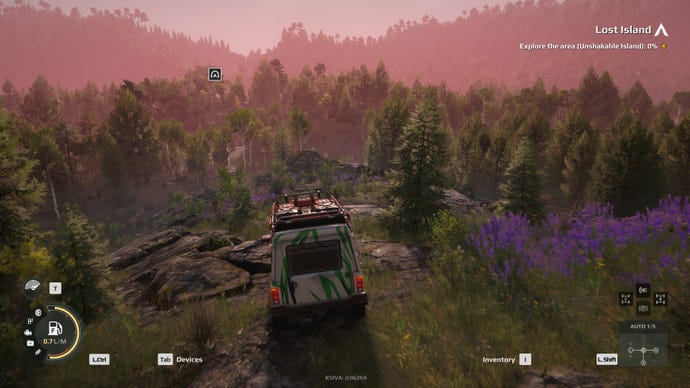
As clumsily explained by its title, Expeditions: A Mudrunner Game is the latest in the Mudrunner/Snowrunner series of driving games, which were originally about driving extremely large trucks through even larger bogs. While I've always been curious about this series, I haven't had the opportunity to sample its eclectic delights until now. Nonetheless, I understand the fundamentals enough to know Expeditions represents a slight sidestep from 2021's Snowrunner, moving it away from hauling freight across an integrated open world, and making it a more session-based affair themed around scientific endeavour.
The basic premise sees you running a sort-of exploration/logistics company tasked with fulfilling science-based contracts in two large environments, namely Arizona and the Carpathian Mountains. Each contract (or 'expedition') has you deploy into one of these environments with a vehicle of your choosing and involves travelling to one or several locations to complete set objectives. You might, for example, have to set up some scientific equipment to measure pollution levels in a Carpathian swamp, or escort a free-range boffin to some ancient stone formation deep in the desert, so they can take photos and interpret their function.
I'll circle back to the game's theme and structure later. For now, let's say it mostly serves to get your vehicles into places they should not normally be. Half-submerged in water, for example, or scrambling up a scree slope littered with the kind of boulders that fearsome cavewomen would crack over the heads of their lousy, good-for-nothing husbands.
In its moment-to-moment, Expeditions is rather wonderful. Although each vehicle handles differently, they broadly function in the same way. Basic driving is as straightforward as in modern Grand Theft Auto, with your only extra concern being a handbrake you need to turn on and off. When terrain get rough and/or wet beneath the wheels, however, Expeditions becomes a little more complicated, with a variety of vehicle functions and techniques to help you bypass the environment's many obstacles. Setting your vehicle to four-wheel drive, for example, will help you power up slopes and get over basic rough terrain. If things get especially lumpy or muddy, you may need to haul your car along with a winch, or deliberately deflate your tyres to increase their surface grip.
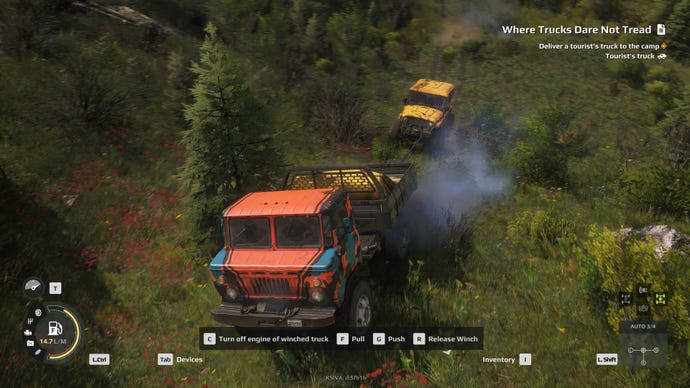
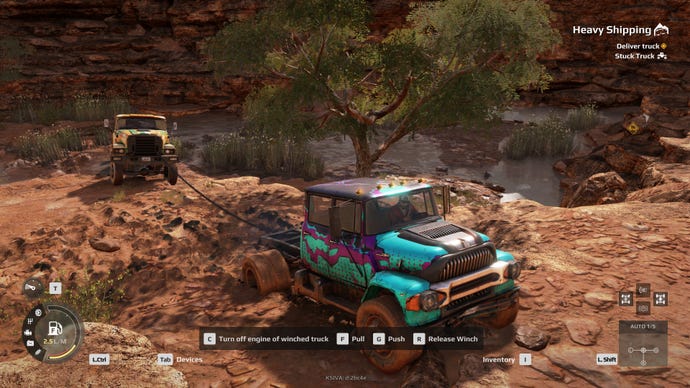
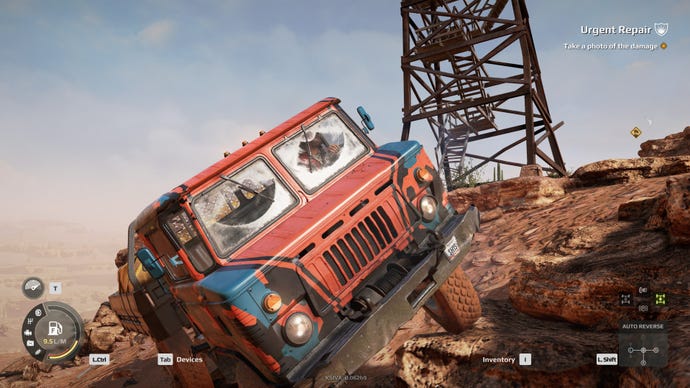
It's surprising how quickly these driving techniques become intuitive. While Expeditions can be a challenging game, you can get around the maps easily enough just by being sensible. Always look for the smoothest route, even if it's more circuitous. If you come to a large body of water, use your sonar to detect where it is shallowest. There's also a fundamental sponginess to the environmental puzzling that allows you to feel out the right way up a slope or down a rocky ditch. You know when your vehicle is likely to tip over or begin to slide back down a hill, so you can adjust your approach accordingly.
That same sponginess is also what makes Expeditions so physically satisfying. The way your vehicle rattles along wind-sculpted rock and gouges its way through bubbly peat lights up the same part of my brain that goes ungh when I turn an imp into giblets with a shotgun in Doom. Its tactile simulation of tyres on terrain is one of gaming's little miracles. And it isn't just the big squelchy mud ponds that are impressive, the game applies that granularity to a wide variety of surfaces, and the contrasting environments help emphasise this. There's a clear difference between the gritty dirt of Arizona compared to the soft undergrowth of the Carpathians. Combined with how uniquely rugged each square inch of terrain is, it makes basic driving enormously gratifying.
The challenge of Expeditions emerges from balancing these short-term obstacles against your longer-term goals. Although it may be tempting to scoot around with four-wheel drive always on and tyres slacker than your comfiest pair of underpants, doing so dramatically increases the amount of fuel you use. You can bring extra fuel with you (with larger vehicles allowing more storage space) but doing so will eat into the profits of your expedition. This isn't the only decision you'll need to make either. You'll fret over how many spare parts to bring, which repair your car or help open new pathways by building bridges or clearing landslides. You can also hire specialists that give you expedition bonuses, making it easier to drive through water, for example.
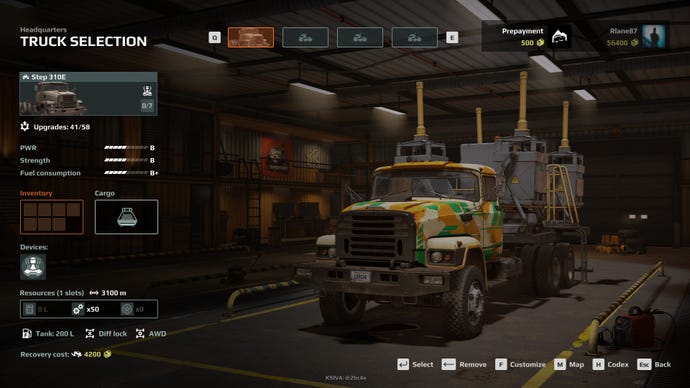
This combination of intuitive physics puzzling and resource management results in a very satisfying off-roading experience. I'm less convinced by the theme and structure. The research angle is a nice idea, but in practice it can be a bit dry. Expeditions are at their best when you have to drive some giant, unwieldy science machine up a big hill for experimental purposes, or even better, tow another vehicle or piece of equipment to that location. Towing stuff in Expeditions is preposterously fun, and I'd take any excuse to connect one truck to another and go bouncing around the mountains together.
That said, many of the expeditions involve driving to a location to perform an underwhelming minigame, like taking photos or visiting rundown fire towers or scanning ponds for fish. Worst of all are the "explore the area" objectives, which essentially ask you to paint an area of the map using your car and binoculars. These are always a faff to complete, as the game measures the completion rate by percentage, so there's always that last three percent of the area that takes ages to pin down.
These objectives might be more compelling if they contributed toward a larger story or were written with more colour. But the game isn't especially interested in either, and doing fake science is quite dull without any characters or stakes to pin it to. Yes, pollution of natural habitats is an important concern in the real world. But I'm not caring about some junk left in a pretend Carpathian swamp unless you make me. It all needs to be a bit more intriguing, whether that's through tying the expeditions together into a proper arc, or adding in some Discovery Channel-style weirdos to root for.
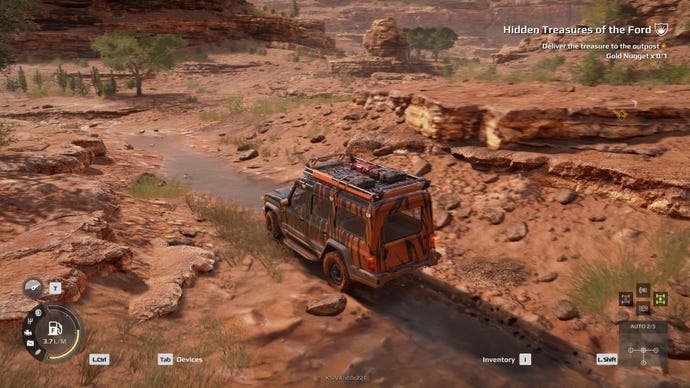
As for structure, while Expeditions' world isn't unified, its maps are large, openly explorable and persistent. If you put a structure down in the world, it stays there forever, and you'll eventually unlock the ability to 'free roam' in these spaces, letting you take on side quests for extra money, and discover points of interest at your own pace. The two environments are equally enjoyable to explore, with each biome generating unique challenges. Arizona is sparse and rugged, so it's wise to brings lots of jacks and anchor points so you can revert your vehicle if it gets flipped, and use the winch when there are no trees around. The Carpathians, by comparison, has so many trees that winch points are abundant, but those trees are also often your main obstacle to progress, with knotty thickets often hindering your progress and obscuring dangerous hazards.
Nonetheless, I find the constant dipping in and out of the world to be quite dissociating. There are shades of Death Stranding to Expeditions' combination of delivery runs and slow conquest of rough terrain, but leaving the world after every expedition spoils the immersion. It doesn't help that the game's menus are harder to navigate than its own wilderness. Setting up your vehicle for an expedition is far fiddlier than it should be, and even something as simple as deploying to the game world is fraught with pitfalls. The game is particularly bad at displaying where objectives are at the outset, which is a problem when you can potentially deploy tens of kilometres away from it. The basic objective marker is greyed out on the deployment map for some inexplicable reason, and if a mission starts with an 'explore the area' objective, good luck finding out which area you're supposed to explore!
These ruts in the road prevent Saber Interactive from delivering a soil-cold classic, but Expeditions: Mudrunner nonetheless succeeds in its primary objective, to build a world where the car and the ground are at irrepressible odds, and it's your job to make them work together to crack the case. That case might prove to be mundane fly tipping rather than anything juicier, but watching our dynamic duo constantly wrestle with one another for supremacy never ceases to be entertaining.
This review is based on a review build of the game, provided by publishers Focus Interactive.









